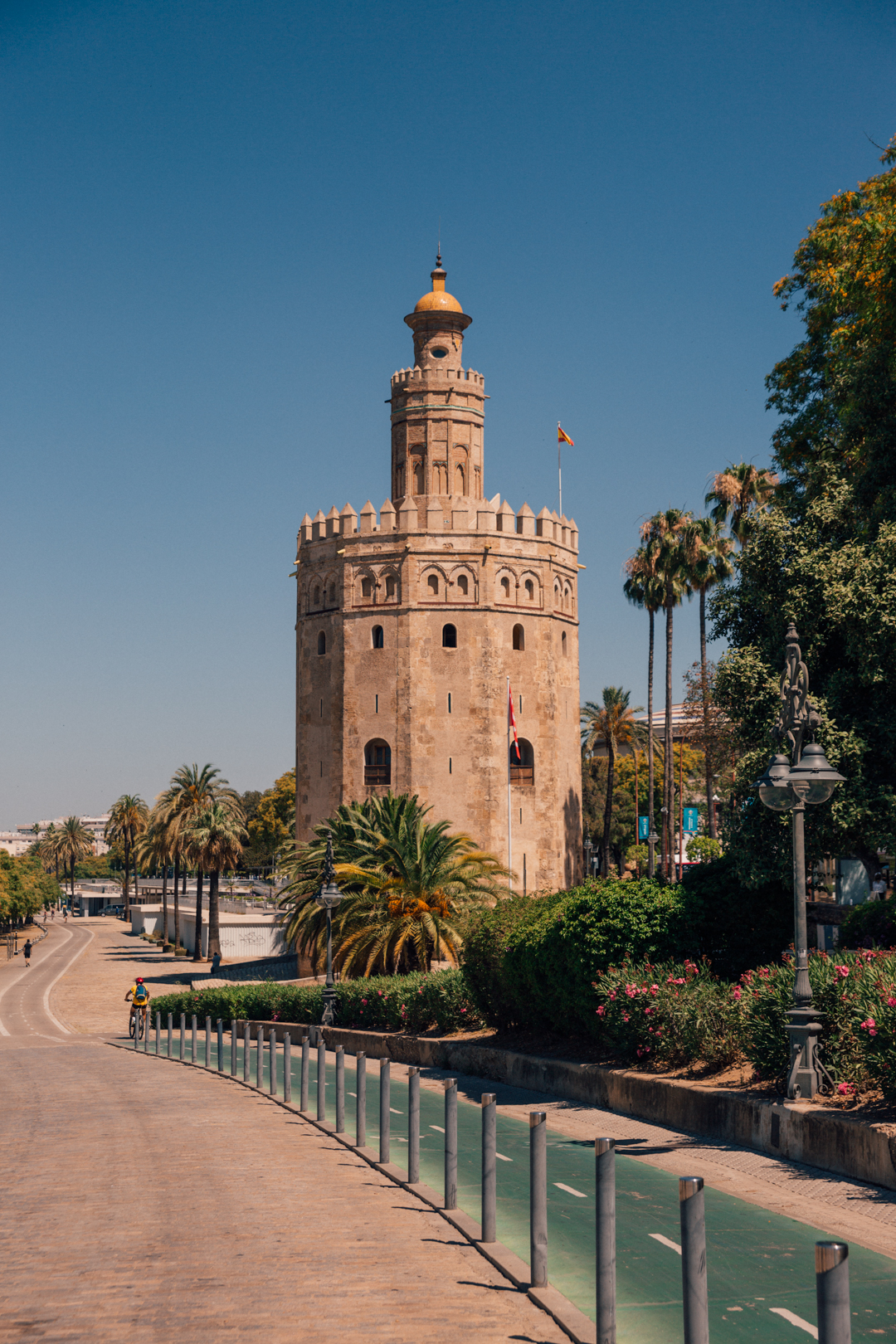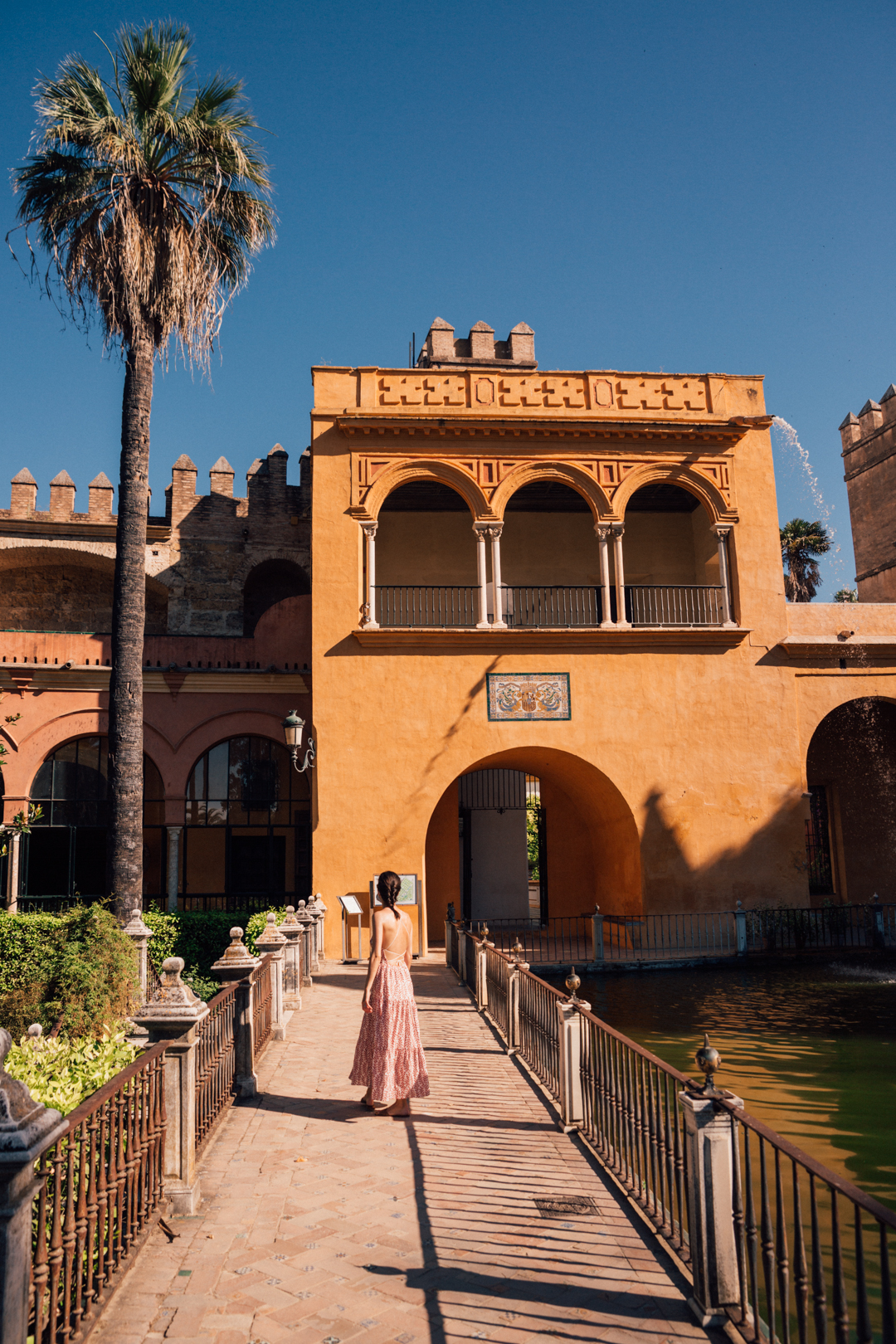Are you planning a journey from Madrid to Seville?
If you’re wondering whether it’s best to drive, or take a train, this article will give you all the answers you need to plan the perfect trip.
Best of all – as I live in Spain, I have plenty of experience navigating public transport and car rentals. I will share lots of practical local tips from personal experience that will save you a lot of time and hassle.
Let’s dive in!
Madrid to Seville Journey Overview
Here is a short recap of your options for your journey from Madrid to Seville.
You will find more details on each of these below.
| Transportation Mode | Details |
|---|---|
| Madrid to Seville by Car | 5 hours |
| Madrid to Seville by Train | 2 hours 40 minutes |
| Madrid to Seville by Bus | 6 hours |
| Madrid to Seville by Plane | 1 hour |

Distance from Madrid to Seville
If you’re thinking about traveling directly between Seville and Madrid, the driving distance between the two cities is about 330 miles, or 530 km. For travelers who are planning to rent a vehicle for their trip through Spain, this is a great option, as the drive can be done within one day.
Expect the trip to take about five hours by car.
The best thing about opting to drive from Madrid to Seville by car is the fact that you can visit either Merida or Cordoba along the way.
Which city you visit depends on the driving route you choose. Both offer at least a few hours of touring historic sites, and great local cuisine. If you leave in the morning, you should have time to enjoy either city before continuing on to Seville.

Madrid to Seville Transportation Options
Here is the rundown with details for each transport option.
Madrid to Seville by Train
Taking the train between cities or even countries is a very popular way to travel in Europe. Trains are safe, well-maintained and highly efficient.
The main train service in Spain is Renfe, and it’s likely the service you’ll be using to book your trip between Madrid and Seville. Iryo, one of the nation’s newer train service providers, is another option.
- Travel Time: 2 hours 20 minutes
- Prices: around 30 euros one way
- First Departure: 7 am
- Last Departure: 10 pm
Operated by Renfe, the high-speed AVE train service is, hands-down, your fastest ground option when traveling between Spain’s capital and Seville.
Trains travel at speeds up to 193 miles per hour (or 310 km). Equipped with WIFI, a buffet area, and power outlets, AVE trains make your trip as comfortable as possible. Expect travel time on the AVE to total about 2 hours and 20 minutes.
The AVE price system has three tiers, starting with the cheapest Basico option and ending with Premium fares. Standard and comfort classes are available, with comfort being similar to first class.
AVE trains allow passengers to bring along 3 luggage items in adherence to the company’s size regulations. Children under 3 years old travel free, while children under 14 receive a 40% discount on tickets. Bicycles and scooters are allowed onboard. Small pets can also travel with you, but they need a special pet ticket.
Even if you don’t end up taking the AVE service, taking the train will likely be the most convenient way to travel between Madrid and Seville. With the trip lasting less than three hours, this option is faster than a bus or car ride and can be much more reliable.
Train schedules are posted in advance, meaning you’ll know exactly when your train will be departing and arriving. This can be extra convenient if you are getting dropped off or picked up, or if you need to plan around hotel check-in times.
Spain’s trains offer a comfortable travel alternative. WIFI, adjustable seats, air conditioning and dining car access are some of the perks available to riders onboard.
I have plenty of experience with the Renfe high speed trains and can only confirm how comfortable and easy the journey always is.
Average ticket prices for one-way trains traveling between Madrid and Seville hover around 30 euros. AVE trains can be even cheaper, with lower prices if booked enough in advance. Prices will depend on when you get your ticket, but they are generally quite affordable when compared to car rentals.
One of the easiest ways to book train tickets between Spanish cities is online, through services like Trainline.
This site is accessible to English speakers and you likely won’t have trouble using a non-Spanish credit card to pay for the ticket. Renfe does have its own website, but there have been reports of foreign users having technical issues while using it. The Renfe app is another option, but I found it has also technical issues, and its only practical for storing your tickets and info.
Tickets can also be bought in person at train stations serviced by Renfe. Stations generally have ticket offices and/or self-service kiosks.
Totaling around 400 kilometers, the train route between the two cities is shorter than the driving route, making traveling by train your fastest option. The first trains generally leave around 6:00 or 7:00 am, and the last depart between 9:00 and 10:00 in the evening. Check schedules online for the most up-to-date information on departure and arrival times.
PS: Practical but important point – when searching for your train, don’t forget to type in Sevilla, not Seville into the search.

Madrid to Seville by Bus
Spain also offers efficient bus transportation between its largest cities. This will likely be a slower travel option, but may be a good idea in a pinch or if you need to save money.
Bus tickets generally cost between 25 and 35 euros, so they are not necessarily much cheaper than the train.
As with train tickets, the further in advance you book, the less you will end up paying.
Alsa, BlaBlaCar and FlixBus are some of the most popular long-distance bus companies in the country. The average travel time for this route totals slightly over 6 hours, and most routes include stops along the way.
Alsa is Spain’s most popular bus service, but BlaBlaCar bus routes may be a better option for direct trips from Madrid to Seville. BlaBlaCar generally offers 2-3 trips in the morning and around two in the evening. However, be sure to check online schedules in advance for more accurate departure and arrival times.
When it comes to purchasing bus tickets, Omio is a great place to get them – you will get times & prices from all the operators I mentioned above. The website can be accessed in English, and customer options are clearly laid out.
Car Rental for Madrid to Seville Trip
If a road trip through Spain sounds like your ideal European getaway, a car rental might be your ticket to freedom.
I recommend using Discover Cars to get the best price on your car rental – they compare prices from all the local car rental companies, with an easy-to-understand interface and plenty of filters, so you can find exactly the car you need for this trip.
You can fill in the form below to get a quick quote.
is an easy-to-use online resource for finding the perfect car rental for you. The website is convenient for English speakers and lists various reliable rental companies throughout the country.
Average rental car costs in Spain total around $200 a day, making this a less budget friendly option. Prices will depend on how far in advance you book, what type of car you rent, and what season you are renting in.
The benefits of renting a car in Spain include the ability to arrange your itinerary however you want.
When traveling between Madrid and Seville, for example, you’ll be able to spend a few hours or even the night in Cordoba or Merida. Once in Seville, you’ll be able to take day drives to the coast, which can add a refreshing spin to an urban getaway.
Cons of renting a car include having to pay for petrol along the way and, like in any city, dealing with traffic. You do have to be at least 21 to rent a car in Spain, so younger travelers should look for other options. If you are not a European Union citizen, you’ll need to get an International Driver’s permit. Permits are inexpensive, but this is something you’ll have to think about in advance.

You will also have to consider where you’ll be dropping off your rental while planning your trip. While drop off locations are available in different cities, this might be inconvenient if you’re not planning to end your trip where you started it.
Car parking can also be quite expensive in city centers, so opt for slightly removed parking spots if you want to save money.
Driving in Spain is generally straightforward, as routes are well-maintained and clearly marked. As in any location, abiding by the speed limit is extremely important. The speed limit will be in kilometers, so you might need to get used to a new metric system.
Be sure to pay attention to parking rules and signage, especially if you’re not used to reading rules in Spanish. Many cities have resident and paid parking spots, so it’s important to keep an eye out for both designations.
Madrid to Seville by Plane
Your final option for traveling quickly between Madrid and Seville is to take a short flight between the two hubs. Iberia Airlines offers low-cost flights ranging around 70 euros one way.
Flights total slightly over an hour, making this a very quick way to travel. There are fewer daily flights available than trains or buses, so keep this in mind when planning your trip.
Flying is definitely a viable option, but don’t forget to factor in travel time to and from busy airports, plus security screening. The flight itself may be speedy, but getting in and out of the airport is bound to take up more of your time.
As always, book your flight in advance to secure lower prices.
When it comes to flights, be sure to remain aware of the weather, as planes are often more sensitive to weather conditions than ground transportation. Also, be sure to consider how you’ll be getting from the airport to wherever you’re staying, which will also add up to the time and also the cost of your trip.

Budget-Friendly Travel Tips
Keeping your trip budget-friendly is all about planning in advance.
The earlier you start booking tickets and stays, the less you’ll spend. The same goes for transportation- while train tickets are generally affordable, with enough advance research, you might find a bus ride or even a direct flight for a similar price.
If you’re set on renting a car, you’ll likely be spending a bit more. However, booking a multi-day rental will usually save you some money on the final rental price.
If you’re planning to spend a while in a single city, look for deals like Madrid’s Tourist Travel Pass, which can help you save money on public transportation.
Traveling with Special Requirements
If you’re a traveler with special requirements or are taking a trip with someone who has them, do some advance research to make sure your trip will be as comfortable as possible.
Disabled travelers, for example, can request a station wheelchair by calling Renfe’s customer assistance hotline. Renfe also offers a service known as Adif Acerca, which can provide physical assistance and information on traveling while disabled. Many of Spain’s museums, historic sites and other attractions are accessible as well.
If you’re traveling with children, look for deals on tickets. AVE trains, for example, offer discounts of up to 40% for children younger than 14. Children younger than 3 travel free of cost.
If you’re traveling with a furry friend, look for pet-friendly transportation options or consider the comfort of renting your own car. Many trains allow pets on board, provided they have their own pet ticket. Buses and flights may have different rules, so be sure to do advance research. Iberia Airlines does allow traveling with pets, but there are certain requirements for the service.

Arriving in Seville
Before you arrive in Seville, it may be helpful to be aware of the amenities at each station beforehand. I have also included my other articles which will give you plenty of inspiration on what to explore once in Seville.
Seville Bus Station
The Plaza de Armas is the location of Seville’s main bus station. The station is centrally located and is near various lodging options. The station is home to ticket offices in case you need to get a return ticket or a ticket to a different city. An information office, cafeteria, restrooms and a locker area are among the facilities offered at Plaza de Armas station.
Seville Train Station
Located east of the bus station, Seville’s Santa Justa Station is also a short distance away from many lodging destinations. It is quite a walk from the true center of the city, though, so you may need to take a taxi. The station is home to stores and eateries, as well as information kiosks.
Seville Airport
Located on the outskirts of the city, the Seville Airport offers easy access to both taxis and the city’s public bus system, which can get you to the city center. The airport is home to various shops, eateries, and even a pharmacy. If you have any questions, there is an information point available to travelers.
Conclusion
Reaching Seville from Madrid is quite easy, and there are multiple options depending on what kind of traveler you are.
Whether you go for the comfort of a rental car, the reliability of a high-speed train, or a good old-fashioned bus ride, Spain’s efficient transportation systems make it easy to move throughout the country- and enjoy the scenery along the way.
Traveling from Madrid to Seville is a great introduction to two very different but equally remarkable Spanish cities. After getting comfortable with Spain’s many transportation options, you’ll be well-equipped to tour the rest of its iconic cities.
Explore More in Seville
Palacio De La Condesa De Lebrija: The Mosaic Palace of Seville
The Church of El Salvador of Seville
Cerveceria Giralda: The 12th Century Hammam Bar in Seville
Casa de Salinas: Seville’s Finest Private Palace Residence
Buy Seville Alcazar Tickets: Expert Insider Tips
Seville Cathedral Tickets: Top Tips To Save Money & Time
10 Gorgeous Photography Locations in Seville, Spain
Disclaimer: This post contains affiliate links – if you decide to book using one of the links, I will earn a small commission that helps me run this site. This is at no extra cost to you.



